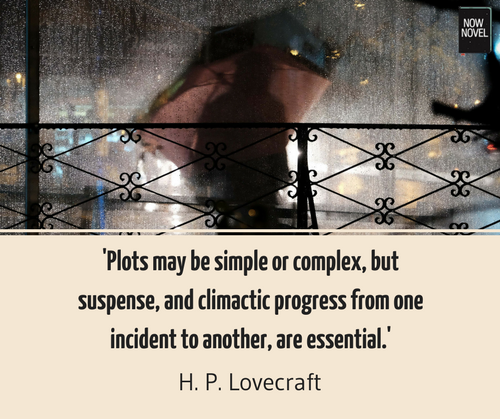Sometimes we overstate the importance of ‘climax’ in a story. After all, some novels end with anti-climax. Bret Easton Ellis even ends a novel mid-sentence. All the same, knowing how to create a gripping build-up is useful, especially if you’re writing a fantasy or thriller. Here are tips gathered from exploring effective story climax examples:
1. Increase external conflict
Increasing external conflict is an obvious way to build to a climax. Conflict brings urgency, propelling the story to a necessary resolution or meltdown.
To refresh, external conflict includes scenarios such as:
- Conflict between characters (competition for power, competing wants or needs, ideological differences in beliefs)
- Conflict between characters and their environment (for example, a survivor trying to make it safely off the sinking Titanic)
In a strong climax, conflicts lead to additional complications:
- Time-dependent developments: Resolution becomes urgent (e.g. The villain will execute a terrifying plan in three days, or the ship will sink completely within one hour)
- Increased obstacles: Challenges characters must overcome to reach their goals (e.g. Two lovers’ disapproving families take further steps to keep them apart)
List complications that forced a main character to take action in a novel you’ve recently read. This is a useful exercise for focusing on the elements of an effective climax.
2. Amplify internal conflict
Internal conflicts – the wars that rage within your characters – are also useful for building to a high point of tension and uncertainty.
Think about tormented characters from literature. Shakespeare’s Hamlet is a classic example. After his father’s ghost reveals that he was murdered, we see Hamlet’s mental state deteriorate.
He becomes increasingly mistrustful and prone to emotional outbursts.
Dostoevsky’s Crime and Punishment (1866) is another story that expertly builds tension out of a single character’s inner torment.
We see the murder committed by the protagonist, Raskolnikov, early in the book. Dostoevsky builds Raskolnikov’s guilt and horror. The novel moves at a slow burn to a climax as the killer teeters ever close to revealing his crime and being caught.

3. Use setting to add uncertainty
Conflict between characters is one of the most obvious ways to build a sense of urgency. The greater the tension and conflict, the greater your reader’s desire for certainty; resolution.
Setting itself, however, is a useful tool for writing a gripping finale.
The hobbits’ passage towards Mordor, in Tolkien’s Lord of the Rings fantasy cycle, is a classic example. As they get closer to the villain’s heartland, the setting becomes darker and more ominous. We have the increasing sense anything could happen (and none of it good).
Tolkien makes Mordor an unsettling, creepy place, full of bad odors and imminent danger. Intensifying setting heightens the climactic elements. We experience the tension multiply. From a character perspective, as the characters near their greatest source of danger, and through the landscape itself.
You can use setting this way in any genre, not only fantasy.
In Damon Galgut’s book In a Strange Room (2010), the author/main character travels with a friend in India. The friend’s mental health deteriorates, and Galgut shows the difficulty of having this experience in an unfamiliar setting. The difficult environment (in a similar way to Tolkien’s Mordor) adds an additional layer of tension and the unknown. There is a sense anything could happen, as the traveler faces unfamiliar, chronically under-equipped hospitals and other unknowns.
4. Use scene and chapter structure to build tension
Another effective way to build your novel’s climax is to structure scene and chapter breaks for effect.
For example, if you have multiple character arcs, try alternating between shorter scenes. Short scenes alternating between characters travelling to the same place (or seeking the same or opposite goals) add tension.
Think of this like effective video editing on a reality TV racing show. The Amazing Race will use editing to show rival teams covering the same ground – some stumbling, some not – in a short space of time.
Create a similar ‘down to the wire’ feeling. From shorter scenes to shorter sentences, use smaller units to ramp up pace. This adds momentum, to create a climax.

5. Increase mystery and suspense
Not all story climax examples feature showstopping gun fights or chases, because conflict isn’t the only source of momentum.
Increase your reader’s suspense by adding mystery to your story arc. This doesn’t necessarily require explicit conflict.
Take William Faulkner’s classic short story ‘A Rose for Emily’, for example.
Although it’s shorter than a novel, the principal of building to a climax remains the same.
The story builds a climax but mostly implies, rather than explicitly shows, conflict.
At the story’s start, the narrator tells us that a woman, Emily Grierson, has died. Faulkner adds suspense by describing her as a ‘fallen monument’ and the curiosity the town feels upon her death. We gradually learn that Emily was a notorious recluse.
In the second section, Faulkner introduces turning points in the past: Emily’s father’s death and her lover leaving her. The townsfolk start complaining about a terrible smell coming from her home. The story builds more suspense with this plot point.
In the third section of the story, Emily mysteriously buys poison (arsenic). It’s only in the fourth and fifth sections of the story that we learn that Emily used it to poison the ‘sweetheart’ everyone thought had abandoned her, Homer Barron.
The climax itself in Faulkner’s story consists of mounting suspense, as mysterious actions (the smell, the reclusive behaviour, the disappearance of the lover) begin to come together. The actual conflict (the poisoning of Homer) remains subtly implied. Thus you can achieve a buildup without a dramatic showdown.
Having read the story conflict examples and tips above, brainstorm plot points for your story. Or take a short course now and get help writing a gripping climax.
Cover source image by Denys Argyriou


19 replies on “Story climax examples: Writing gripping build-ups”
hi
hi jACK
Hi Jack, do you have any writing-related questions? Thanks for visiting our blog.
hi there, could I get the exact date of when this post was posted?
Hi there, thank you for asking. It was posted on the 23rd of November 2017.
how to start climax in my story!!
Hi Alexa, this would depend on the events in your story preceding the climax. I would say look back to what the key unresolved conflict is and work from there. For example, if in the Lord of the Rings the destruction of the One Ring is the ultimate objective and the main villain the conflict in the way, the climax would bring the characters closer to their object (destroying the ring) as well as a closer brush with the villain.
In a romance, the big unknown might be whether two romantic leads end up together. The climax would bring them closer than ever, yet most likely with more obstacles and last-minute revelations that make it a close call whether or not they end up together. Does this make sense? Please feel free to ask me anything.
Hi there,
I am writing a story about a woman who was knocked down and is set on an adventure that leads to her own growth and self-discovery. While I have plenty of ideas for conflict, I am uncertain what a climax should look like for a story like this. At the end, I need her to realize who she is, what she wants, and be excited about the future. For some reason, I can only think of a romantic climax or a thriller climax. I don’t know what a climax could be for a young woman’s self-realization. Does that make sense? Would you be able to help?
Thank you!
Hi Meagan,
Thank you for sharing your interesting challenge regarding your main character’s arc. Given that your protagonist is knocked down and goes on an adventure, my immediate thought was that perhaps there is some kind of injury/disability or other challenge arising out of this she has to overcome?
This would make the climax perhaps more one of overcoming a personal setback than the romantic/thriller climax options you want to avoid.
Another form of self-realization could be the woman’s discovery of a new ability in the process (I remember the biopic about the amazing artist Frida Kahlo introduced her story with a tram accident that is like an awakening of sorts, as she channeled the resulting pain into her art).
I hope these ideas are helpful. I would suggest brainstorming a number of effects of the accident, since you already have the cause.
Good luck!
Hey Jordan,
I hope your name is that. Anyways, I’m writing a horror story but stuck with the ending of it. Could you please help me out? To make it more clear for you, let me give a glimpse of my story:-
Its all about a group of students entering into a haunted mansion next to a resort where they have come for camping along with their teacher and other classmates. These 12 students, enter the haunted house as a part of a challenge and get into a huge trouble. As time passes, one by one dies. At the end no one is left except for a girl and her boy best friend. She will be recalling all these incidents in her old age and gets interrupted by her grand daughter. This little girl will be holding an old, rusty camera in her right hand and a picture of her grand mom in her left hand. Now this camera isn’t an ordinary one. This predicts the future of the things captured by it.
Now I want you to suggest me as to what kind of death should be planned for this old lady?
Hi G. That is my name indeed. That sounds interesting, it has a few of the classic horror tropes such as a group of friends being picked off one by one when they make ‘the wrong choice’ (venturing into the house).
Regarding your ending, perhaps there could be a twist of some kind in that the camera actually reveals a very ordinary death but something about that makes it ‘horrifying’, in a way? The reader may expect something gory or on the same level/in the same fashion as the other characters’ deaths, so think how you could play with this expectation, perhaps, for a surprise twist.
[…] Story climax examples – Now Novel […]
Hello, Jordan!
Interesting article! I enjoyed the part about using shorter sentences to shape the climax.
Could you please help me find resources about using language in general and linguistic features in forming a climax? Thanks!
Hi Rania,
Thank you for reading our blog and for your feedback. I would suggest Googling for resources, as so much has been written around narrative structure and there have been many interesting academic studies too (e.g. this study where 60,000 traditional narratives were analyzed for structural similarities). I would look into studies around the ‘Story Cloze benchmark’ if interested in looking at linguistic features in writing a climax. However I think one can simplify this away from a linguistic study and just read examples and ask yourself ‘why is this a good/bad ending?’ What is apropos or (if it doesn’t work) ineffective about the ending?
Brilliant!
Thank you, Jordan!
Hi, Jordan.
I need some advice for a romance story. It includes two teens who absolutely despise each other in the beginning because they are forced to be friends by their parents. I wasn’t too sure how I could create an interesting build up and climax that could make conflict in their relationship.
Thanks so much, I appreciate it!!
Hi Luciel, thank you for sharing that.
It sounds a classic ‘hate at first sight’ set-up where proximity forces the love interests to re-evaluate their initial prejudices towards each other.
It sounds as though there would be conflict from the start, so I would suggest (to give the conflict an arc) this being over petty things mainly to start, then becoming more fundamental or ‘personal’ as the story goes on (for example, if they discover a larger clash of personal values, or one betrays or is is dishonest to the other, etc.). They might dislike each other initially for somewhat superficial reasons, but as they get to know each other due to their parents’ interference, they would also likely know each other’s buttons/triggers better and how to ‘twist the knife’, so to speak.
It’s difficult of course to advise on the specifics of conflict without knowing more about each character, the nature of their parents’ connection, the events of the story and so forth. I hope this helps!
Hi, Jordan
I am writing a suspenseful short story where the main character is schadenfreude and a serial killer. He is very discreet with his victims, ensuring no one knows they are gone. Sadly, that is all I have, I still need to make it into a story, but I don’t know what the climax should be, how to get there, or…well… anything else about the story. If you could give me a few tips that would mean a lot.
Hello Lucia, I’d suggest brainstorming around some of the ideas you have. Who are the victims? Are they randomly chosen? Or carefully chosen? This may provide a clue as to why he is doing the killing, and might even lead you to the killer’s past.
Try to plot out the story, no matter how brief it may be at first, see where this takes you. You could draw a mind map and have the ideas spiralling off from there. This may suggest what your story could be about, and what the climax might be.